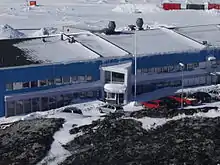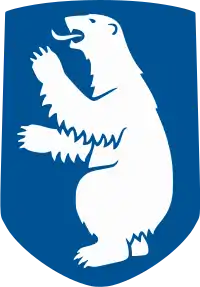Telecommunications in Greenland
Telecommunications in Greenland include radio, television, fixed and mobile telephones, and the Internet.
Greenland has, by law, only one service provider for telecommunications and the Internet, TELE Greenland, which is fully owned by the Greenlandic Home Rule government.[1] TELE Greenland provides switched telephone and data, land mobile communications, and VHF and MF shore-to-ship communication.[2] This type of monopoly is not uncommon in Greenland.
Radio and television

Television in Greenland began in the 1960s.
Privately owned transmitters were created to receive TV from Canada, Iceland, and mainland Denmark. This can date as far back when television was introduced to Greenland in the 1960s. It was possible to receive TV from Canada with a normal household TV antenna, but color transmissions were NTSC and signals were in very bad quality and however in some circumstances, television transmissions were not available at all due to factors such as weather conditions or time of day, even for the people who owned private transmitters. Greenland did not have any local TV service until 1982.
The state broadcaster is Kalaallit Nunaata Radioa (KNR, Greenlandic Broadcasting Corporation), which provides one television and one radio service nationwide.[3] Both broadcast in Greenlandic and Danish. Administered as an independent public corporation by the Greenlandic government, KNR has a seven-person board and management committee. They employ 100 people and are funded publicly and by advertising.[4]
A few private local TV and radio stations are also available as Danish public radio rebroadcasts.[5] An umbrella organization in Greenland, known as the STTK, operates local radio and TV stations throughout the country.[6] There are also American Forces Network stations, operated by the United States Air Force.
Greenlanders owned an estimated 30,000 radios and 30,000 television sets, as of 2002.[7]
Telephones
- Calling code: +299[5]
- International call prefix: 00[8]
- Main lines: 18,900 lines in use, 188th in the world.[5]
- Mobile cellular: 59,455 lines, 200th in the world (2012).[5]
There are no area codes in Greenland, and all telephone numbers have 6 digits.
There are adequate domestic and international telephone services, provided by cables and microwave radio relay. The system was totally digitized in 1995. The Greenland Connect submarine cable provides connectivity to Europe via Iceland and to North America via Newfoundland.[9] TELE Greenland first used satellite communication in 1978 and currently uses 15 satellite earth stations (12 Intelsat, 1 Eutelsat, and 2 Americom GE-2), all over the Atlantic Ocean.[5]
Mobile
Today, Greenland has more mobile phones than landlines.
As of 2007 there are 66.400 active GSM (2G) and UMTS (3G) subscriptions in use in Greenland. In 2007, all NMT (1G) networks were shut down. Nova was first to offer 4G.[10]
Mobile coverage extends to nearly all inhabited areas in Greenland, but there are some remote areas that do not have mobile coverage.
In Greenland, VHF radio-telephone is also used. Users make calls over a radio instead of a phone. Outside of Greenland, VHF phones are only used on ships, but in Greenland they can also used as regular phones. Greenland does not have telephone connection over the whole country, so sometimes it may be easier to use a VHF phone. In 2001, 42% of Greenlanders owned a portable VHF phone.
Internet
- Greenland has one Internet Service Providers (ISP): Tele Greenland (Tele Post Greenland A/S).
- Greenland has one major data center: Tele Greenland Nuuk.
- The country code for top-level domains is: .gl[5]
- There are 15,645 Internet hosts which places Greenland 123rd in the world (2012).[5]
- 37,442 people or 64.9% of Greenland's population were able to use the Internet (2012).[11][12]
- There were 11,117 fixed broadband subscriptions placing Greenland 146th in the world with a 19.4% penetration rate ranking Greenland 50th in the world (2012).[11][13]
- There were 2,803 mobile broadband subscriptions placing Greenland 144th in the world with a 4.9% penetration rate for 111th ranking (2012).[14]
- Greenland has been allocated 16,384 IPv4 addresses, less than 0.05% of the world's total or 284 addresses per 1000 people (2012).[15][16]
- Internet and telephone services rely on the Greenland Connect submarine communications cables for external traffic.
Internet censorship and surveillance
As a territory of the Kingdom of Denmark, Greenland has a democratically elected home-rule government whose powers may encompass all matters except foreign and national security affairs, police services, and monetary matters. Greenlanders have the same rights throughout the kingdom as other citizens.[17]
The Danish government places no restrictions on access to the Internet and there are no credible reports that e-mail or Internet chat rooms are monitored without appropriate legal authority. Authorities continue to employ an Internet filter designed to block child pornography. In no known cases did the filter affect legitimate sites. The Danish Constitution provides for freedom of speech and press with some limitations such as cases involving child pornography, libel, blasphemy, hate speech, and racism, and the government generally respects these rights in practice.[17]
In April 2013, the registrar for the .gl domain unilaterally voluntarily suspended resolution of thepiratebay.gl, intended to be a new primary Domain Name for the famous Bittorrent search engine The Pirate Bay.[18] This caused transient inconvenience to some File Sharing Internet users.
See also
- Internet censorship in Greenland (Kingdom of Denmark)
References
- "TELE -". www.tele.gl. Archived from the original on 15 January 2016. Retrieved 25 April 2018.
- "TELE Greenland A/S" Archived 12 October 2012 at the Wayback Machine, Telecommunication Development Bureau, International Telecommunication Union (ITU), 17 December 1997. Retrieved 8 November 2009.
- Kalaallit Nunaata Radioa (KNR): Greenlandic Broadcasting Corporation Archived 1 October 2014 at the Wayback Machine.
- "About KNR" Archived 5 September 2012 at the Wayback Machine, Kalaallit Nunaata Radioa (KNR): Greenlandic Broadcasting Corporation, 2008. Retrieved 8 November 2009.
- "Communications: Greenland" , World Factbook, U.S. Central Intelligence Agency, 3 December 2013. Retrieved 8 January 2014.
- "Greenland profile – Media". BBC News. 29 May 2012. Archived from the original on 31 January 2017. Retrieved 18 January 2017.
- Jenny B. David, "Greenland Press, Media, TV, and Newspapers" Archived 9 January 2014 at the Wayback Machine, Press Reference, 2002. Retrieved 8 November 2009.
- Dialing Procedures (International Prefix, National (Trunk) Prefix and National (Significant) Number) (in Accordance with ITY-T Recommendation E.164 (11/2010)) Archived 18 August 2013 at the Wayback Machine, Annex to ITU Operational Bulletin No. 994-15.XII.2011, International Telecommunication Union (ITU, Geneva), 15 December 2011. Retrieved 2 January 2014.
- "The marine cable: Greenland Connect" Archived 9 January 2014 at the Wayback Machine, TELE Greenland. Retrieved 8 January 2014.
- TeleGeography. "TELE Greenland opens 4G network to smartphone users". www.telegeography.com. Archived from the original on 4 March 2016. Retrieved 25 April 2018.
- Calculated using penetration rate and population data from "Countries and Areas Ranked by Population: 2012" Archived 29 March 2017 at the Wayback Machine, Population data, International Programs, U.S. Census Bureau, retrieved 26 June 2013
- "Percentage of Individuals using the Internet 2000–2012" Archived 9 February 2014 at the Wayback Machine, International Telecommunications Union (Geneva), June 2013, retrieved 22 June 2013
- "Fixed (wired)-broadband subscriptions per 100 inhabitants 2012" Archived 10 July 2017 at the Wayback Machine, Dynamic Report, ITU ITC EYE, International Telecommunication Union. Retrieved on 29 June 2013.
- "Active mobile-broadband subscriptions per 100 inhabitants 2012" Archived 10 July 2017 at the Wayback Machine, Dynamic Report, ITU ITC EYE, International Telecommunication Union. Retrieved on 29 June 2013.
- Select Formats Archived 13 May 2009 at the Wayback Machine, Country IP Blocks. Accessed on 2 April 2012. Note: Site is said to be updated daily.
- Population Archived 25 June 2014 at the Wayback Machine, The World Factbook, United States Central Intelligence Agency. Accessed on 2 April 2012. Note: Data are mostly for 1 July 2012.
- "Denmark" , Country Reports on Human Rights Practices for 2012, Bureau of Democracy, Human Rights and Labor, U.S. Department of State, 22 March 2013. Retrieved 8 January 2014.
- "New Pirate Bay Greenland Domains (About to be) Seized". TorrentFreak. 10 April 2013. Archived from the original on 30 April 2013. Retrieved 13 May 2013.
 This article incorporates public domain material from the CIA World Factbook document: "2013 edition".
This article incorporates public domain material from the CIA World Factbook document: "2013 edition". This article incorporates public domain material from websites or documents of the United States Department of State.
This article incorporates public domain material from websites or documents of the United States Department of State.
External links
- TELE Greenland
- KNR, Greenlandic Broadcasting Corporation.
- Greenland Television
- STTK
.svg.png.webp)
